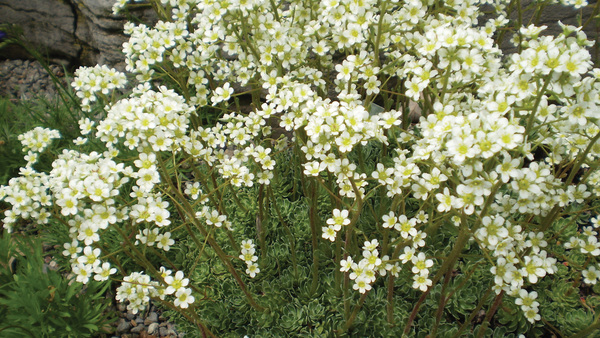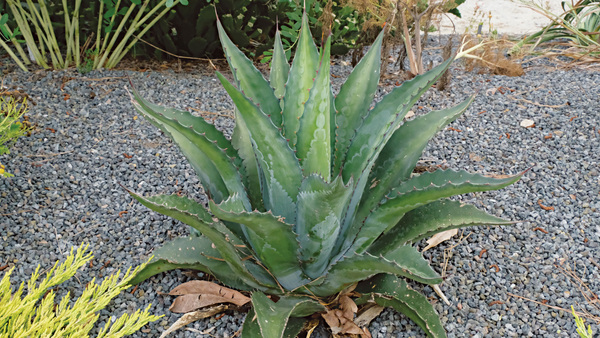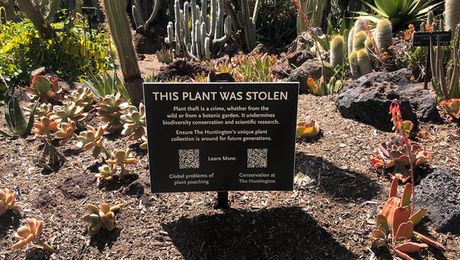
Japanese holly fern
Cyrtomium falcatum
Zones: 6–10
Size: 1 to 2 feet tall and 2 to 3 feet wide
Conditions: Partial to full shade; moist to average, well-drained soil
Native range: Asia
This fern will never win any races, as it grows very slowly up here in the north. Consistently evergreen in warmer zones, a well-placed Japanese holly fern will blaze through winter unscathed in the Midwest. If it gets nipped by Jack Frost, though, you can just snip it clean and pretend that didn’t happen. I’ve had great luck growing it in raised beds with good drainage and up against a house where there is some residual heat and protection from wind. On the underside of the holly-like fronds are spore-producing structures called sori that will absolutely horrify anyone with trypophobia (an aversion to the sight of irregular patterns of small holes or bumps).
‘Dark and Handsome’ hellebore
Helleborus ‘Dark and Handsome’
Zones: 4–9
Size: 18 to 24 inches tall and wide
Conditions: Partial to full shade; moist to dry soil
Native range: Europe, Asia
With their evergreen foliage and super-early blooms, hellebores make great “front door” plants for northern gardens; if you put them any farther away from the house, you might miss the show. When customers ask me to recommend shade garden plants, I usually suggest hellebores with cheerful colors, since the blooms of many varieties face downward under foliage and appear at a gloomy time of year. But in my own garden, give me ‘Dark and Handsome’ all day long. The smoky, double, 3-inch-wide flowers bloom for me before April. Those who grow this plant in warmer zones may have problems with rampant spreading, but that is a hardship I will never know.
‘Cobweb’ hens and chicks
Sempervivum arachnoideum ‘Cobweb’
Zones: 5–8
Size: 3 to 5 inches tall and 8 inches wide
Conditions: Full sun to partial shade; poor to average, well-drained soil
Native range: Mountains of southern Europe
I have an old flagstone wall where I love to cram in different varieties of Sempervivum, and this is one of the coolest ones. The “cobwebs” are what make this cultivar so fascinating; the threads that zig and zag across the leaf tips make it look like the plant has been claimed by some very intense, artistic spiders. As with other hens and chicks, there is a mother plant with little chicks growing around her—and when Mom eventually dies, the chicks take over. It’s a cruel world! People never believe me when I tell them this plant is hardy here, but it is, and with no maintenance required. It is also very heat tolerant and likes to grow in poor soil.
Blue wood sedge
Carex flaccosperma
Zones: 5–8
Size: 6 to 12 inches tall and wide
Conditions: Partial to full shade; average to wet soil
Native range: Eastern North America
Blue wood sedge is a slow-growing, roundy-moundy little clump of bliss for wet shade. Because of the
similarities between their common and botanical names, it is sometimes mixed up with blue sedge (Carex flacca, Zones 4–9), which is a roguish ruffian that doesn’t know when or how to stop. Blue wood sedge, on the other hand, is the adorable, well-behaved, blue pompom you are looking for. It truly loves wet shade, but it can become a bit braver about tolerating drought conditions once it is established. Although technically evergreen, this woodland beauty may need a little cleaning up or cutting back in March.
Amanda Thomsen owns Aster Gardens, a small plant and garden shop in Lemont, Illinois. She frequently neglects her home garden but would like to tell you what to do with yours.
Fine Gardening Recommended Products

A.M. Leonard Deluxe Soil Knife & Leather Sheath Combo
Fine Gardening receives a commission for items purchased through links on this site, including Amazon Associates and other affiliate advertising programs.























Comments
Log in or create an account to post a comment.
Sign up Log in